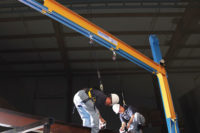Will terror strike your workplace?
Fear of terrorism far exceeds the actual risk – but if you see something, say something

It’s New Year’s morning and I’ve just finished my local newspaper. The front page is about a 25-year-old Rochester man arrested in a reported ISIS-inspired plot to abduct or kill patrons in a neighborhood bar on New Years Eve.1
The suspect is described by people who know him as a mentally ill petty criminal and parolee. He attempted suicide several times both in and out of prison and his most prominent recent activity has been picking up cigarette butts near the target restaurant. Knowing this, I’ve been able to keep my fear of radical terrorism under control.
However, Lorenzo Vidino and Seamus Hughes of the Program on Extremism at George Washington University, in a December 2015 report titled “From Retweets to Raqqa”, tell us that there were a record number (56) of terrorism-related arrests in the U. S. in 2015.2
They report that a huge amount of the radicalizing propaganda takes place within social media and especially on Twitter. There is also some face-to-face influence.
How is the nation reacting to all this news? Not well, I’d suggest. Terrorism has reached number one in most “fear” polls. Politicians are beating the fear drum the loudest and predicting the end of the United States as we know it if you don’t “elect me and reject the other stupid people” seeking office.
How to react
Here’s the big question: As a safety practitioner, what do you do with this information? Here are my suggestions:
1 - Don’t panic!
It’s pretty clear that many issues have relatively low risk but generate huge amounts of attention.
Terrorism is a prime example. Five years ago, it was not ranked at all in surveys when people were asked what they fear most. But in January 2015, the Pew Research Center had 76 percent of the population ranking terrorism No. 1.3 Reducing crime came in at 57 percent, moral breakdown 48 percent, and global warming was 38 percent. No ranking for occupational safety.
Other surveys done in 2015 conducted by widely respected national poling organizations found terrorism at 14 percent, 28 percent, 12 percent and “not ranked”. Based on media attention to domestic terrorism, however, it seems there is no greater fear today among the American public.4 Yet the data shows that in 2015, 19 Americans lost their lives in ISIS-related activities within the U.S.—tragic numbers but minute compared to other causes of preventable death.
Since 2001, jihadist attacks have killed 45 people in the United States. In the same period, however, there have been 48 people killed in this country by right-wing radicals.5
2 - Consider the source
There is often little data or evidence behind wild stories and claims—especially during the political season.
Politifact6 the Pulitzer Prize-winning independent fact-checking division of the Tampa Bay Times, found during 2015 that the most truthful candidate for president lied only about 30 percent of the time while the least truthful hopeful president lied about 76 percent of the time, often at “pants on fire!” levels. Unfortunately, it appears that lies don’t seem to bother a significant percentage of the electorate.
Social media has changed the dynamic for news reporting. Stories travel at the speed of lightning, but often have no accurate attribution, are filled with assumptions and can drive a huge response for both good and very bad. If a story on social media raises a red flag, check it out with reliable sources before you react.
3 - Do research, gather data, look at statistics, see what’s real and what’s wild
Driving while drunk is high on my list of concrete threats. U.S. DOT statistics for 2010 put driving under the influence estimates at four million drivers and 112 million alcohol-impaired driving episodes.7 More recent data suggests these figures are low.
Add to this concern the related driving while distracted issue. At any given daylight moment across America, approximately 660,000 drivers are using cell phones or manipulating electronic devices while driving.8 In 2013, it was estimated that 341,000 motor vehicle crashes involved texting.9
Also on my list of real threats is the number of people with guns who shouldn’t have them. Rather than stopping crime, guns are much more likely to kill family members, workers and other innocents. In 2015, both traffic accidents and guns each killed 34,000 people in the United States. Over 60 percent of the people in the U. S. who die from guns are suicides! The issue is not about taking guns away; it’s about keeping people with mental health issues from having easy access to guns.10 The data is clear. States with more guns have more suicides.11
But, that’s not to say that you and I are not at risk from having 88.8 guns per 100 citizens in the U. S. According to news site Vox, “America has six times as many firearm homicides as Canada and 15 times as many as Germany”12 And how about Australia, the wild frontier populated originally by criminal exports from England? 1.4 homicides by firearm per 1 million people, the lowest rate in the world. America is highest with a rate of 29.7! On average, the U. S. had one mass shooting per day (335) in 2015—two of which were attributed to Islamic terrorists.13
While mass shootings do not change overall views about gun control vs. gun rights in any significant direction in the U.S.; a strong majority of the population support specific gun control policies such as private and gun show background checks (85 percent) and preventing people with mental illness from purchasing guns (80 percent)14
4 - Pay attention to behaviors rather than appearances or labels
I grew up in a lily-white small town in Western New York State, but then I spent 20 years in the U. S. Navy. It’s hard to live on a 365-foot ship with 300 men (this was before women went to sea with the Navy) and not realize very quickly that skin color or religion means nothing when every person on the ship has a critical job to do and inadequate performance can be life-threatening.
So it is in the workplace. Assume that everyone there is a “good” person unless their behavior tells you otherwise. Does someone argue a lot, threaten, start fights, disregard reasonable requests? Take the issue to management and get some help deciding what’s going on. There are “bad” people in every ethnic group, religion and social persuasion; but you find that out by observing behaviors and addressing those.
5 - “See Something! Say Something!”
To “see something,” you have to have eyes on the problem. That concept led me to research by economists Jillian Carr and Jennifer Doleac that found that curfews can increase levels of violence! That’s right, keep people off the street and violence goes up. Carr and Doleac looked at the effect of a juvenile curfew in Washington, D. C. and found a resulting 50 percent increase in incidents of gunfire during late hours. Their conclusion was "removing bystanders and witnesses from the streets could reduce their deterrent effect on street crime.”15
Consider that concept in the workplace. If “eyes” improve safety and security, what’s the impact of depending on lone operators and super lean operations? With smartphones, there may be an app for that, but does an app and a phone really replace the human observation and interaction that the workplace may require?
A silent workplace
Returning to my opening story may be useful here. The FBI’s criminal complaint stated the suspected ISIS sympathizer and a confidential FBI informant visited a city Walmart and bought a machete, ski masks, knives, zip-ties, duct tape, ammonia and latex gloves. The informant reportedly paid for the goods since the suspect had no money. [It’s also reported that the informant was paid several thousand dollars for his efforts on the case, but that’s another story.]
What happened with the idea of “see something, say something?” This was a workplace. Presumably employees, particularly cashiers, are trained to be observant as part of their loss prevention responsibilities. Does it seem strange that a collection of goods, considered in total to be useful for only nefarious purposes, would be allowed to walk out the door without the cashier quietly asking store security to at least get a plate number from the buyer’s car? That’s what “see something, say something” is all about.
Look for the indicator
I can’t leave this section without mentioning a short piece of very sound advice from Jim Satterfield, President of Firestorm, the crisis management organization. It’s a statement that I’ve heard often from Jim and it’s true of any problem, crisis or system failure—“There is always a tell!” Whether it’s a statement, a social media post, an action or a surprising development or turn of events, there is always an indicator of something bad to come. Since it’s there, it’s up to the organization to see it.
Look at the terrorist attack in San Bernardino, California in December. Weapons, clothing, thousands of rounds of ammunition, pipe bombs—all in a small apartment after years of planning. This should have been a huge “tell” if anyone had been looking. Certainly in the workplace there are tells—aggressive language, angry looks, safety rules not followed, sloppy work, a nasty social media post—that require a closer look.
6 - Create and maintain a positive, supportive culture
Abundant research repeatedly proves that a culture that works drives safety and productivity and overall business success. It’s the culture of conflict that worries me. How many times do you see a workplace where kidding has a mean edge, where good ideas are squashed, where someone is ignored because they are “different” or a supervisor is “too busy” to engage a worker?
At the Inland Regional Center in San Bernardino, there were reports that Syed Farook was kidded for his beard and conservative appearance. Clearly, this activity might have had no impact at all on the attack given the years of planning; but reaching out is still a far better route than poking fun.
When I visit the “best” companies on my long list of clients over the years, I see organizations where bad things seldom happen, where everyone pulls together, where help is offered if it appears needed, where everyone is respected for what they offer the team and were people are not afraid. That’s how life should be.
1 http://www.democratandchronicle.com/story/news/2015/12/31/rochester/78122594/
2 https://cchs.gwu.edu/sites/cchs.gwu.edu/files/downloads/ISIS%20in%20America%20-%20Full%20Report.pdf
3 http://www.people-press.org/2015/01/15/publicspolicy-priorities-reflect-changing-conditions-at-homeand-abroad/
4 http://www.pollingreport.com/prioriti.htm
5 https://www.washingtonpost.com/news/wonk/wp/2015/12/23/11-ways-that-2015-made-history/
6 http://www.politifact.com
7 http://www.rita.dot.gov/bts/sites/rita.dot.gov.bts/files/publications/by_the_numbers/drunk_driving/filespublications/by_the_numbers/drunk_driving/index.html
8 http://www.distraction.gov/stats-research-laws/facts-and-statistics.html
9 http://www.huffingtonpost.com/2015/06/08/dangers-of-texting-and-driving-statistics_n_7537710.html
10 http://www.nytimes.com/2015/10/09/upshot/gun-deaths-are-mostly-suicides.html?_r=06
11 http://www.vox.com/2015/8/24/9183525/gun-violence-statistics
12 ibid
13 ibid
14 ibid
15 http://www.vox.com/2016/1/3/10702498/gun-violence-curfews
Looking for a reprint of this article?
From high-res PDFs to custom plaques, order your copy today!







